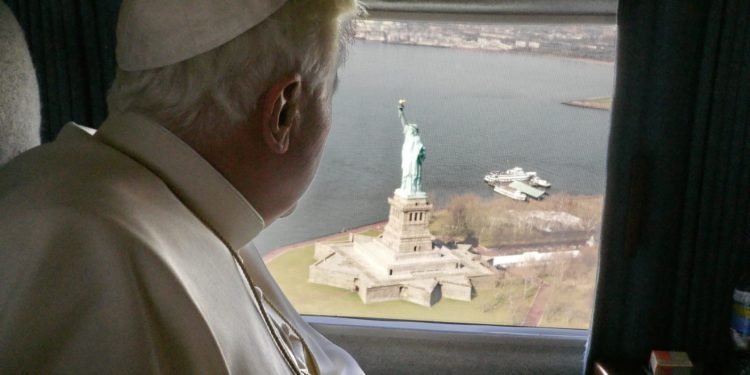Explaining his purpose of his trip, he said: “I have come to repeat the Apostle’s urgent call to conversion and the forgiveness of sins, and to implore from the Lord a new outpouring of the Holy Spirit upon the Church in this country.”
In closing, the pope returned to his call for a renewal of the Church in America, saying that it “depends on the renewal of the practice of Penance and the growth in holiness which that sacrament both inspires and accomplishes.”
Later that day, Benedict addressed the heads of more than 200 U.S. Catholic colleges and universities and 195 Catholic dioceses’ superintendents at The Catholic University of America on the topic of Catholic identity in education.
The pope told the educators: “A university or school’s Catholic identity is not simply a question of the number of Catholic students. It is a question of conviction — do we really believe that only in the mystery of the Word made flesh does the mystery of man truly become clear? Are we ready to commit our entire self — intellect and will, mind and heart — to God? Do we accept the truth Christ reveals? Is the faith tangible in our universities and schools? Is it given fervent expression liturgically, sacramentally, through prayer, acts of charity, a concern for justice, and respect for God’s creation?”
“Only in this way do we really bear witness to the meaning of who we are and what we uphold,” he said.
He also met with representatives of other religions, including Jewish leaders.
The pope said in his address: “The task of upholding religious freedom is never completed. New situations and challenges invite citizens and leaders to reflect on how their decisions respect this basic human right. Protecting religious freedom within the rule of law does not guarantee that peoples — particularly minorities — will be spared from unjust forms of discrimination and prejudice. This requires constant effort on the part of all members of society to ensure that citizens are afforded the opportunity to worship peaceably and to pass on their religious heritage to their children.”
Benedict then left the U.S. capital and headed to the country’s largest metropolis, New York City. After a warm welcome at John F. Kennedy International Airport, the pope headed to Manhattan to address the United Nations.
That year, 2008, marked the 60th anniversary of the Universal Declaration of Human Rights, and the pope said in his speech that human rights are inherent to human persons and not the fruit of an “agreement.” These rights, therefore, cannot be manipulated by ideological and pressure groups.
On April 20, the last day of his visit, Benedict visited Ground Zero, the memorial site of the World Trade Center towers. Sixteen family members, four first responders, and four survivors were present — and later met with the pope — as the Holy Father descended the ramp down into the pit where the Twin Towers once stood, knelt, and silently prayed.
After lighting a candle, the Holy Father offered a prayer for the victims, their families, and those who survived all three attacks on 9/11. He then blessed Ground Zero and the people present with holy water.
(Story continues below)
Later that day, some 60,000 people attended Mass with the pope at Yankee Stadium in New York. The pope said in his homily that true freedom is found in self-surrender and turning away from sin. The Mass also served to celebrate the 200th anniversary of the creation of the Dioceses of New York, Boston, Philadelphia, and Louisville from the mother Diocese of Baltimore, which itself was elevated to an archdiocese in 1808.
The pope then departed the United States, again from Kennedy International Airport. It remains his only visit to the United States; the next pope to visit the U.S. would be Pope Francis in 2015.
Credit: Source link





